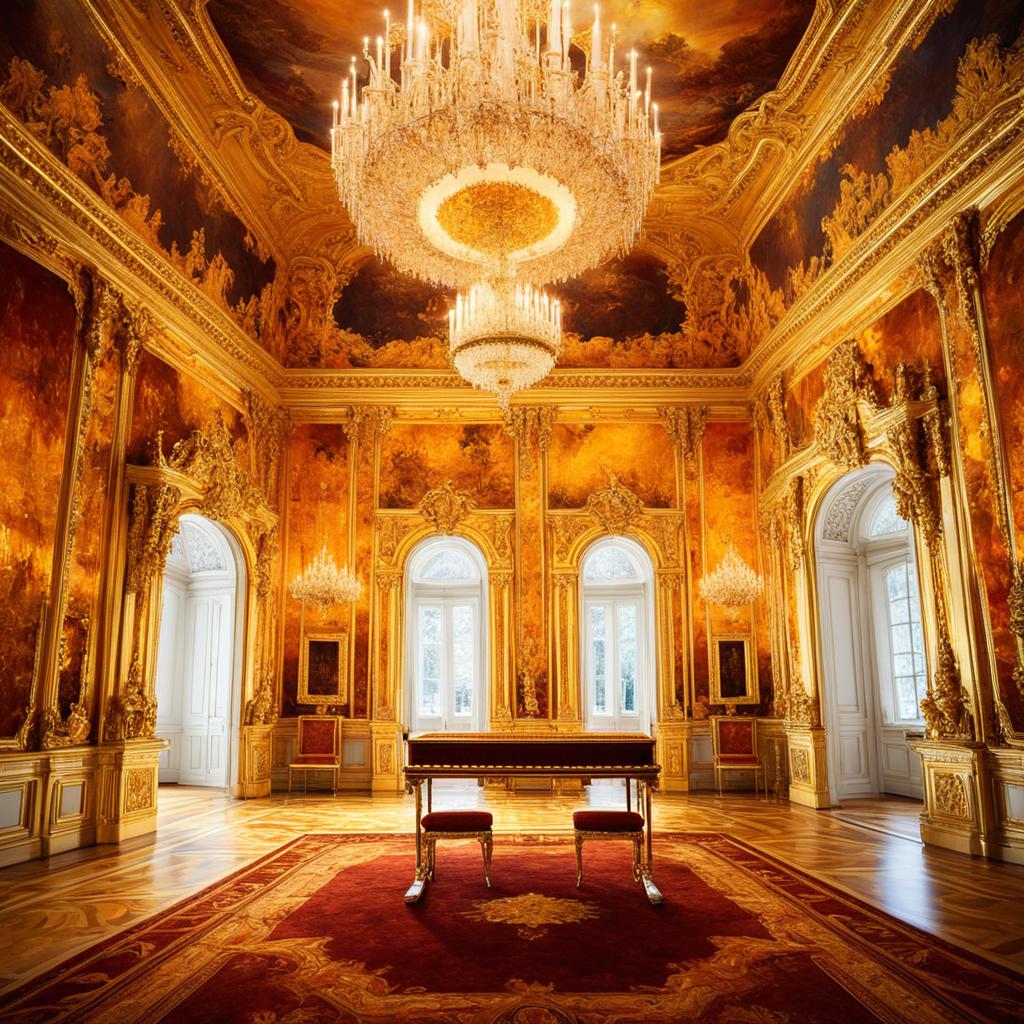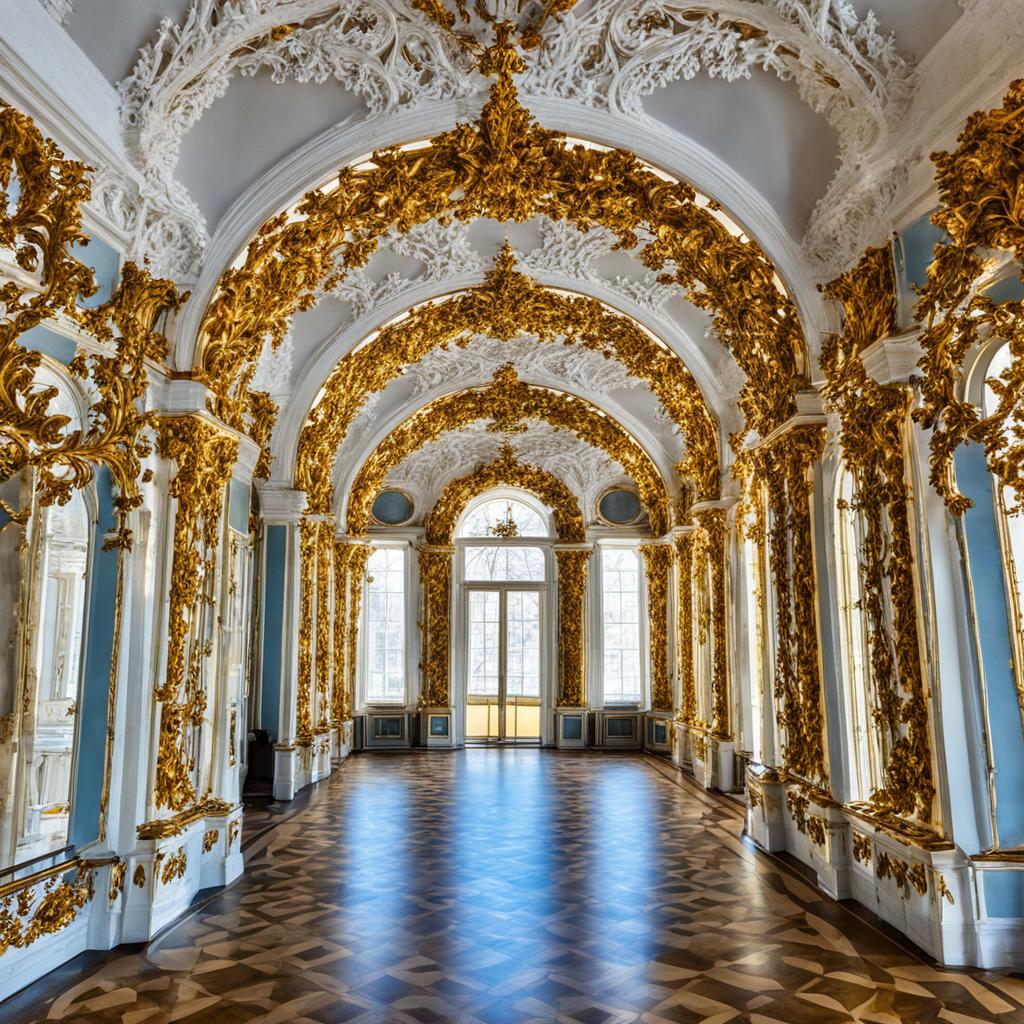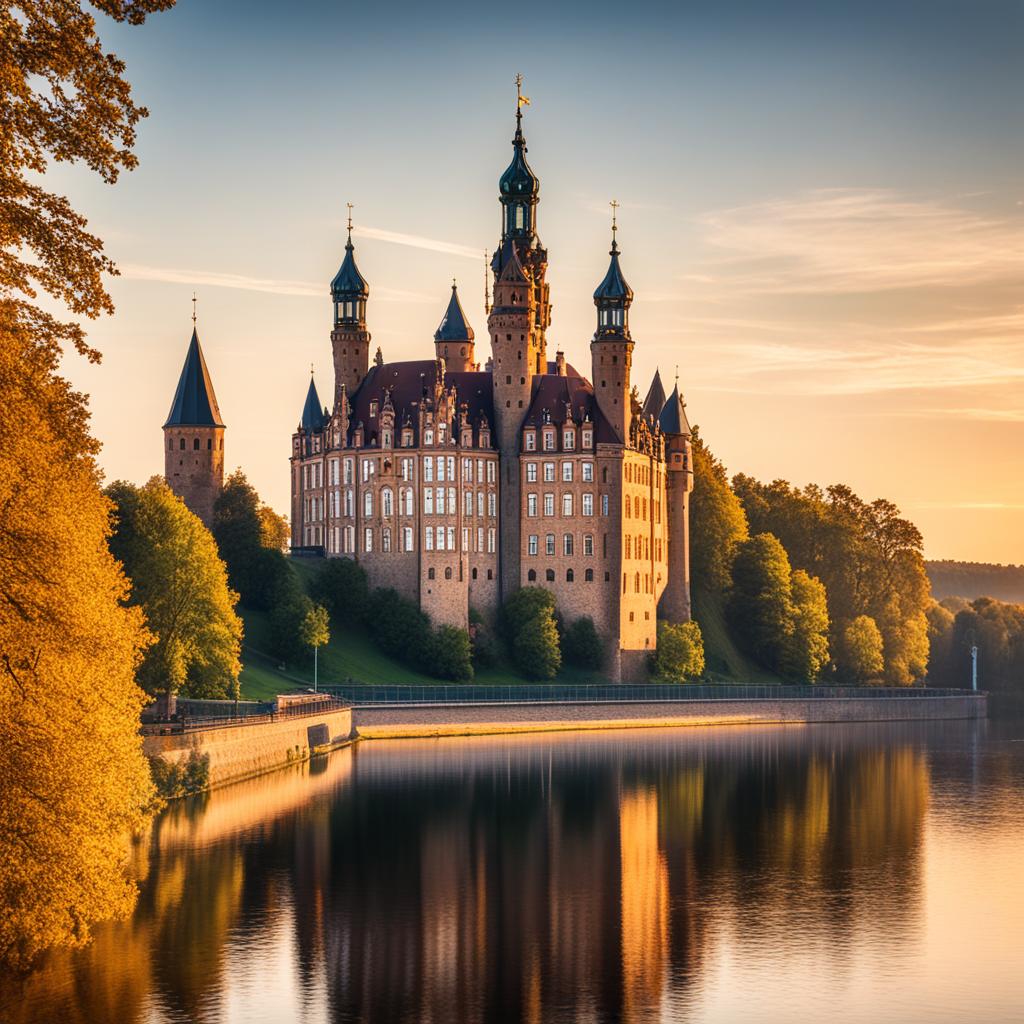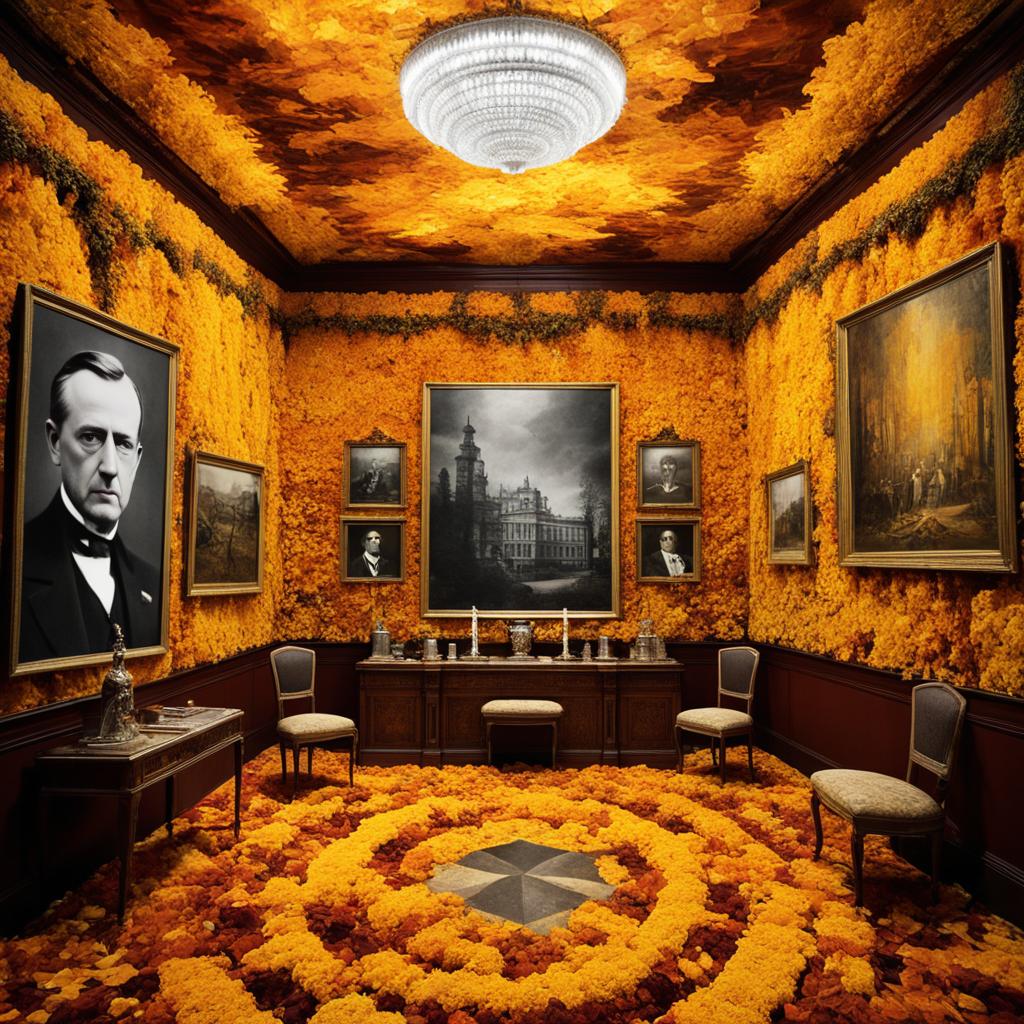The Amber Room, dubbed the “Eighth Wonder of the World,” was a treasure of Russia. It was looted by Nazi Germany in World War II. This room spanned over 590 square feet and contained more than 6 tonnes of amber. Its value reached £120-£240 million in current terms.
The room vanished after the Nazi invasion of the Soviet Union. The event birthed many conspiracy theories and remains a subject of fascination for historians.
The Amber Room was created in the early 18th century by Prussian royalty. It was then offered to Tsar Peter the Great to symbolize Russian-Prussian unity. Located in the Catherine Palace in Pushkin, near St. Petersburg, it became a prominent feature of the Russian Empire.
However, the room faced a tragic destiny during the Nazi invasion in 1941. This attack initiated a chain of events leading to its mysterious disappearance, which endures as a historical enigma.
Origins of the Enigmatic Amber Room
The Amber Room stands as a masterpiece from the 18th century. It was a dazzling collaboration among 70 craftsmen and scholars, reflecting the grand vision of the Prussian Royalty. The project took 25 years to complete. Initially started in 1701, it reached its zenith at Tsarskoe Selo, the Russian imperial city.
The Commissioning by Prussian Royalty
Andreas Schlüter, a celebrated German baroque artist, designed the Amber Room for Charlottenburg Palace. Construction kicked off in 1701. The work was led by Gottfried Wolfram, supported by amber artisans Ernst Schacht and Gottfried Turau. Despite its original destination, the Amber Room found its place at the Berlin City Palace. It caught the eye of Peter the Great during his 1716 Russian state visit, leaving a lasting impression.
The Gifting to Peter the Great
In an effort to solidify an alliance against Sweden, Frederick William I executed a strategic move. He gifted the Amber Room to the Russian Empire, thereby strengthening their bond. This gesture placed the Amber Room in the Catherine Palace, where its splendor earned it the title of “the Eighth Wonder of the World” in the 18th century, mesmerizing all who saw it.
“The Amber Room was a true marvel of the 18th century, a testament to the vision of the Prussian Royalty and the skilled craftsmanship of the era.”


Relocation to the Catherine Palace
The Amber Room, a once prized symbol of Prussian royals, now calls the Catherine Palace home. This grand palace rests in Pushkin, just beyond St. Petersburg, serving as the summer estate for the Imperial family. The Amber Room’s journey involved intricate reworking over ten years, eventually covering over 55 square meters. It contains more than 6 tons of Amber, currently worth about £240 million.
The Catherine Palace is a dazzling exhibit of Imperial Russia’s glory, replete with stunning architectural features. Sterling carvings, Amber panels, and gold leaf shine throughout. It’s also filled with angel and child statues, along with well-placed mirrors, all bathed in a sumptuous candlelit ambiance.
“The Amber Room was a true masterpiece of craftsmanship, a testament to the skill and artistry of its creators. Its relocation to the Catherine Palace was a testament to the grandeur of Imperial Russia’s cultural heritage.”
The Amber Room’s shift highlights the opulence and artistic flair of the Imperial court. As the centerpiece of the palace, it remains a source of wonder and inspiration. A beacon of the lasting impact of Imperial Russia and the Catherine Palace.


The Looting by Nazi Forces
As the German assault on the Soviet Union, known as Operation Barbarossa, surged through Eastern Europe, the Catherine Palace’s cultural treasures faced dire peril. The Amber Room, a celebrated part of this, was targeted by Nazis for looting. The curators tried to dismantle it to protect it but found it extremely brittle, making their task nearly impossible.
They then undertook a risky move, concealing the Amber Room behind everyday wallpaper. They hoped this trick would outwit the Nazi invaders, safeguarding the Amber Room. Yet, against their hopes, Hitler’s determination to acquire the room was not swayed. He deemed it a crucial artifact of Germany’s culture.
Hitler’s Obsession with Reclaiming the “German” Artwork
Hitler was relentless in his effort to bring the Amber Room back to Germany, showcasing the nation’s cultural might. A dedicated group from the Army Group North quickly unveiled the room’s true nature. Underneath the deceptive wallpaper, they found the Amber Room’s authentic beauty. This valuable piece was carefully disassembled and moved to Königsberg Castle, hidden away for a long period.


“The Amber Room was among the most valuable cultural treasures looted by Nazi forces during World War II, a testament to their obsession with reclaiming artwork they believed to be of German origin.”
This event was just one example of the widespread looting the Nazis undertook. Across occupied territories, they confiscated an estimated two million cultural items, which included art, books, and more. Notably, many of these pieces were never recovered. This cultural theft was a strategic part of the Nazi agenda, aiming to consolidate power and manipulate history.
The Room’s Rediscovery in Königsberg
For two years, the Amber Room was shown at Königsberg Castle. It had been moved from the Catherine Palace. Yet, with the Allies gaining ground, the Germans feared losing their cultural treasures. Under Hitler’s orders, the Amber Room and other valuable items were swiftly taken further into German territory.
Since its move from Königsberg Castle, the Amber Room’s story has been a mystery. Various accounts and records conflict, leading to uncertainty about its exact journey. Its disappearance as the Third Reich fell has left an enduring puzzle, sparking intense interest. The quest to locate the missing masterpiece has inspired many theories and tales over the years.


Despite the war and its tumultuous aftermath, the Amber Room’s appeal remains strong. Its rediscovery at Königsberg Castle, even briefly, ignites hope and fascination in the search for this lost treasure. With the mystery still unsolved, the world eagerly anticipates the revelation of what truly happened to this significant work of art.
The Cataclysmic Events of World War II
The Königsberg bombings during World War II were a sorrowful episode for the Amber Room. The year 1944 saw the city undergo severe fire bombings carried out by the Royal Air Force. Subsequently, the advancing Red Army bombarded the city again in 1945.
This dual assault led to severe damage, instigating the search for the Amber Room. It was Alexander Brusov, outlining in Russian archives, who noted the loss of the Amber Room. Brusov was the chief of a Soviet team devoted to recovering stolen arts. His work suggested the Amber Room likely perished in the attack.
According to Brusov’s findings, only one of the four iconic mosaics from the Amber Room survived. The three others were found scorched and harmed in the castle’s basement. These discoveries highlighted the disastrous toll World War II had on the Amber Room. Its destruction profoundly altered the destiny of this irreplaceable artifact.
The Bombings of Königsberg
The bombings of Königsberg, renamed Kaliningrad after the war, left it devastated. The Royal Air Force and the Red Army aggressively bombarded the city. This led to extensive destruction of its historical center, including the Amber Room’s location. It is a somber reminder of the brutality of the war and its impact on art and history.


“The Amber Room was most likely destroyed in the resulting damage to the castle.”
– Alexander Brusov, Head of the Soviet team charged with locating lost arts
Historical Conspiracies: The Mysterious Disappearance
The missing Amber Room’s story is entrenched in mystery, triggering historical conspiracies through the years. Alexander Brusov’s investigation revealed clues, yet the Soviets continued to hunt for the missing Amber Room at the castle. Some theories suggest this search was Cold War era propaganda, deflecting from Soviet destruction.
Eyewitness accounts further muddle the truth about the Amber Room’s destiny. Many theories exist, but factual evidence of its current location is absent. The idea that the Soviets were looking into their own troops regarding the room’s demise was once considered, despite Russian authorities’ refutation.
“The mystery of the missing Amber Room has captivated the public’s imagination for decades, spawning a web of historical conspiracies and unanswered questions.”
The amber Room’s vanishing stands as a poignant symbol of World War II’s destruction. The missing Amber Room draws the attention of both scholars and admirers. The quest for the masterpiece remains active. However, the truth behind this disappearance might remain a mystery, allowing speculation about its fate to persist.
Eyewitness Accounts and Theories
The Amber Room’s vanishing act has sparked numerous theories and eyewitness reports, all captivating in their own right. Perhaps the most poignant tale involves the sinking of the Wilhelm Gustloff, a German vessel, by a Russian submarine in 1945.
Reports claim some saw the Amber Room placed onboard the Wilhelm Gustloff in Gdynia, Poland. It’s said Nazis hid the artwork aboard, hoping to protect it. Yet, the ship’s tragic fate—sunk with over 9,000 souls—meant the Room’s true destiny remained a mystery.
The Wilhelm Gustloff Theory
The Wilhelm Gustloff’s story grips the public’s interest, drawing many to explore its sunken remains. Nevertheless, no concrete proof linking the Amber Room to the ship has been discovered. The Room’s whereabouts remain a subject of guesswork, from ancient salt mines to the seabed.
The legend of the Amber Room’s riddle continues to captivate, its various tales enhancing the intrigue. Indeed, this story about a vanished masterpiece weaves together history, art, and suspense in a truly enthralling manner.


“The Amber Room is one of the most enigmatic and sought-after treasures in history. Its disappearance has fueled countless theories, each more captivating than the last.”
The Fruitless Search Efforts
The quest for the legendary Amber Room has captivated adventurers and scholars for years, yet it remains hidden. In the search, the KGB scoured the area around Königsberg, where the room was last seen. Their detailed searches hinted the Amber Room might be beneath the city, within its tunnels and hidden rooms. However, no evidence of the valuable treasure has been unearthed.
But the mystery deepened with tangled tales and Soviet misinformation. The destruction of Königsberg Castle in 1968 by Soviet leader Leonid Brezhnev halted local inquiries. This act restricted the chance to explore the castle’s grounds, believed to be the Amber Room’s final location. The episode also saw the Amber Room’s disappearance used in Cold War tactics, yet this idea has been refuted by modern Russian officials.
Conflicting Narratives and Propaganda
A flurry of stories has enshrouded the Amber Room’s absence in mystery, complicating search missions. From accounts of it hidden in bunkers to being destroyed and its materials repurposed, a variety of scenarios exist. However, these tales are often viewed as hypothetical, lacking substantial proof.
In spite of extensive efforts, the Amber Room’s vanishing act remains a puzzle. Over time, interest in uncovering the truth has only intensified. This unsolved enigma continues to fascinate the global community with its tantalizing secrecy.
“The Amber Room was a masterpiece, a true wonder of the world. Its disappearance is one of the greatest unsolved mysteries of the 20th century.”
The Reconstruction of the Lost Masterpiece
The Amber Room was a stunning display of Baroque art. It once adorned the walls of the Catherine Palace near Saint Petersburg. Sadly, it disappeared during World War II. Despite its loss, the allure of this masterpiece persisted. This led to an extraordinary project to rebuild the Catherine Palace and the famous Amber Room.
In 1979, the Soviet government embarked on the immense challenge of remaking the Amber Room. They used historical descriptions, photos, and defined architectural plans as guides. The work required a dedicated team of craftsmen and 24 years to complete. Finally, on Saint Petersburg’s 300th anniversary in 2003, the new Amber Room was revealed.
The craftsmanship was a true labor of passion. Artisans meticulously replicated the amber panels, detailed carvings, and rich gilding from the original. The outcome was a breathtaking recreation. It reflects the beauty of the lost masterpiece. Now, visitors to the Catherine Palace can once more admire the radiant charm of the Amber Room.
Though the original Amber Room is still a mystery, its recreation has rekindled interest in its story. The new Amber Room was meticulously constructed to honor the past. It is a symbol of the lasting appeal of the reconstruction and the Catherine Palace. This ignites the wonder of both visitors and scholars.
Conclusion: The Enduring Allure of the Missing Amber Room
The Amber Room, a priceless 18th-century piece, was dubbed the “Eighth Wonder of the World.” It vanished during World War II, creating one of the war’s top mysteries. Despite all efforts, its disappearance remains unsolved. This has left historians, treasure hunters, and the public fascinated.
This loss inspired many literary and cinematic works. These include the captivating novel “The Amber Room” and ongoing real-life investigations. Notably, Russian nationalists, German descendants, and other groups are still searching. The story is about more than just the missing room; it’s also about our cultural history and the effects of war on art.
The Amber Room’s mystery highlights the importance of preserving our heritage. It stands as a symbol of the impact of war on treasure. Whether it is found or not, its story will inspire people for generations. The allure of its missing beauty remains strong.
